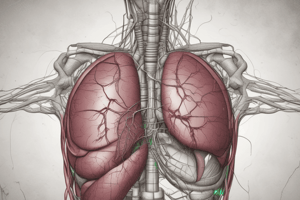Podcast
Questions and Answers
What is the primary clinical symptom of congenital liver cysts in asymptomatic cases?
What is the primary clinical symptom of congenital liver cysts in asymptomatic cases?
- Vague pain (correct)
- Chronic fever
- Severe jaundice
- Biliary obstruction
Which treatment option is indicated only for symptomatic congenital liver cysts?
Which treatment option is indicated only for symptomatic congenital liver cysts?
- Surgical excision
- Percutaneous aspiration (correct)
- Regular follow-up ultrasound
- Cyst ablation
Which of the following features indicates complexities in congenital liver cysts?
Which of the following features indicates complexities in congenital liver cysts?
- Simple wall structure
- Internal debris (correct)
- Small size
- Consistent shape
Peribiliary cysts are commonly associated with which of the following conditions?
Peribiliary cysts are commonly associated with which of the following conditions?
What is often required for further investigation of congenital liver cysts with complexities?
What is often required for further investigation of congenital liver cysts with complexities?
What is the primary characteristic of complete agenesis of the liver?
What is the primary characteristic of complete agenesis of the liver?
Which condition is characterized by the liver herniating through the diaphragm?
Which condition is characterized by the liver herniating through the diaphragm?
What describes the liver position in situs ambiguous with left isomerism?
What describes the liver position in situs ambiguous with left isomerism?
Which of the following is a variant characterized by a tongue-like extension of the liver?
Which of the following is a variant characterized by a tongue-like extension of the liver?
What is the main characteristic of congenital liver cysts?
What is the main characteristic of congenital liver cysts?
What type of anomaly is indicated by the term 'vascular anomalies' in the liver?
What type of anomaly is indicated by the term 'vascular anomalies' in the liver?
Which of the following describes a symptom associated with situs inversus?
Which of the following describes a symptom associated with situs inversus?
What does the presence of diapragmatic slips indicate?
What does the presence of diapragmatic slips indicate?
Which of the following is NOT a type of congenital abnormality of the liver?
Which of the following is NOT a type of congenital abnormality of the liver?
Which condition is associated with an increased incidence of congenital heart defects?
Which condition is associated with an increased incidence of congenital heart defects?
Flashcards are hidden until you start studying
Study Notes
Developmental Anomalies
- Agenesis: Complete absence of the liver is incompatible with life. Partial agenesis of liver lobes can occur, with compensatory hypertrophy of remaining lobes and normal liver function tests.
- Anomalies of Position: Situs anomalies, congenital diaphragmatic hernia (CDH), and omphalocele can lead to the liver being positioned outside its normal location.
- Situs Inversus: Complete mirror image reversal of heart and upper abdominal organs.
- Situs Ambiguous (Heterotaxy):
- Right isomerism (Asplenia): Midline liver, no spleen.
- Left isomerism (Polysplenia): Midline liver, multiple spleens.
- Situs anomalies are associated with congenital heart defects.
- CDH: Liver herniates through the diaphragm into the thoracic cavity.
- Omphalocele: Liver herniates outside the abdominal cavity through a defect in the anterior abdominal wall.
Normal Variants
- Reidel’s Lobe: Tongue-like extension of the right lobe, extending inferior to the right kidney, sometimes reaching the iliac crest. More common in females than males. Sonographically appears similar to the rest of the liver.
- Caudate Process: Inferior appendage of the caudate lobe located between the main portal vein and the inferior vena cava. Sonographically appears the same as the rest of the caudate lobe.
- Diaphragmatic Slips (Accessory Fissures): Invaginations of the diaphragm into the liver parenchyma. Sonographically appear as echogenic "pseudomass" that elongates with transducer orientation changes.
- Vascular Anomalies: Variations in hepatic artery origin, anomalies in portal vein (rare) such as atresias, strictures, or absent right portal vein, and anomalies in hepatic veins (common) such as accessory branches or absence of a vein.
Congenital Abnormalities
- Liver Cysts: Fluid-filled lesions with epithelial lining, possibly resulting from anomalous development of hepatic ducts. Common, appearing around middle age. They can be asymptomatic but may cause pain from large cysts, hemorrhage, or infection. Treatment is only indicated for symptomatic cases.
- Peribiliary Cysts: Located around the porta hepatis or right/left hepatic duct junctions, often occurring in patients with severe liver disease. Result from obstructed glands around biliary ducts. Can be asymptomatic but may cause biliary obstruction, pain, or jaundice.
- Autosomal Dominant Polycystic Disease: Inherited disorder causing cysts to develop in various organs, including the liver.
- Biliary Hamartomas: Benign tumors made up of mature liver cells.
- Mesenchymal Hamartomas: Benign tumors made up of connective tissue.
Liver Cysts (Sonographic Appearance)
- Appear as solitary or multiple, simple cysts.
- May have internal debris or septations, suggesting hemorrhage or infection.
- Thick walled cysts
- May require further investigation with CT, MRI, or follow-up ultrasounds.
- Differential diagnoses include abscesses, parasitic cysts, post-traumatic cysts, and cystic neoplasms, including malignant ones.
Peribiliary Cysts (Sonographic Appearance)
- Appear as simple cysts.
- Often small in size.
- May be located near the porta hepatis or right/left hepatic duct junctions.
Studying That Suits You
Use AI to generate personalized quizzes and flashcards to suit your learning preferences.




